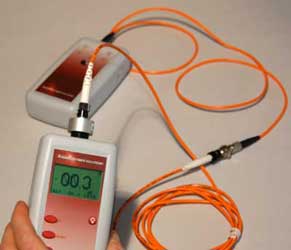Checking Out the Perks of Optical Fiber Evaluating for Improved Interaction Systems
The value of optical fiber testing in modern communication systems can not be overemphasized, as it serves as a foundation for making sure network dependability and efficiency. This aggressive testing technique has profound effects for signal quality and operational effectiveness, raising the inquiry of exactly how these practices contribute to long-lasting sustainability in an ever-evolving technical landscape.
Importance of Optical Fibre Testing
The value of optical fiber testing can not be overstated in today's data-driven setting. As organizations increasingly depend on high-speed information transmission for day-to-day operations, the stability and performance of optical fibre networks are critical. Checking guarantees that these networks can support the large amounts of data generated and transmitted flawlessly, fostering effective interaction and connection.
Optical fiber screening offers multiple crucial features, consisting of confirming setup high quality, identifying potential mistakes, and identifying general system efficiency. Regular testing can prevent pricey downtimes and solution interruptions, enabling organizations to keep functional continuity. It aids in conformity with sector criteria and regulations, making certain that fibre optic setups meet needed requirements for security and reliability.
Additionally, screening can enhance the durability of fibre optic systems. By proactively identifying problems such as signal loss, depletion, or port failures, companies can address issues prior to they rise, hence prolonging the life of their framework. In summary, optical fiber testing is not simply a technological demand yet a critical financial investment that boosts network reliability, optimizes performance, and inevitably sustains the development and performance of modern interaction systems.
Trick Evaluating Methods

OTDR is an essential technique made use of to determine mistakes, step splice losses, and evaluate the overall integrity of a fibre optic web link. By sending a pulse of light down the fibre and examining the shown light, professionals can identify locations of mistakes and review the network's efficiency over long distances.
Insertion loss testing determines the amount of signal loss that happens when light passes through a link or splice. This method is important for confirming that links meet specific loss limits, which is important for keeping optimum performance in interaction systems.
Optical return loss testing quantifies the quantity of light showed back towards the resource because of imperfections in the fiber or links. High return loss worths show better performance and lowered signal degradation.
With each other, these testing approaches provide a comprehensive analysis of fiber optic networks, ensuring their dependability and capability in diverse interaction applications.
Effect on System Performance
Reliable optical fiber testing directly influences the total efficiency of interaction systems. By making certain the integrity of fiber optic cords, testing recognizes prospective mistakes such as attenuation, splice loss, and connector imbalance. These problems can considerably degrade signal top quality, resulting in disruptions and decreased information transmission rates.

Additionally, routine optical fiber testing contributes to long-term system sustainability. It enables very early discovery of wear and tear, permitting prompt upkeep and upgrades before major failures happen. This not only extends the life-span of the framework yet also makes sure that interaction systems stay affordable in terms of performance.
Cost-Effectiveness and Performance
Cost-effectiveness is a vital consideration in the implementation and maintenance of optical fibre networks. Applying durable optical fibre screening procedures can considerably lower operational expenses by determining concerns prior to they rise right into significant troubles. robotic vision. By identifying mistakes, attenuation, and other efficiency limitations early, companies my response can stay clear of expensive repair work and downtime, which can disrupt solutions and result in income loss
Additionally, efficient screening methodologies improve the setup process, permitting technicians to work better. This translates to lower work prices and faster job conclusion times. Advanced testing devices, such as Optical Time Domain Reflectometers (OTDRs), allows an exact assessment of fibre quality, guaranteeing that only ideal products are used, therefore reducing waste.
Regular screening likewise adds to much better resource allocation. By recognizing the network's efficiency, companies can make educated decisions concerning upgrades and expansions, making certain that financial investments are made where they are most needed. In recap, optical fibre testing boosts cost-effectiveness and effectiveness, supporting the long-term sustainability and competitiveness of interaction systems in a significantly demanding market.
Making Certain Long-Term Integrity
Implementing extensive optical fiber testing not only enhances cost financial savings and functional performance however likewise plays a critical function in making sure the long-term reliability of communication networks. Regular testing practices, including attenuation and data transfer assessments, aid recognize potential deterioration in fibre performance prior to it results in service interruptions.
By using advanced screening techniques, network operators can determine faults or weak points in the fiber framework, enabling prompt remediation. This proactive read review strategy minimizes downtime, making certain that interaction systems stay useful and effective. Moreover, routine testing adds to the growth of a much more resistant network, as drivers can adjust and maximize their infrastructure based upon real-time information understandings. optical fibre testing equipment.
Additionally, making sure conformity with market criteria through optical fibre testing enhances the top quality and stability of the entire communication system. This adherence not only reinforces confidence among stakeholders yet likewise aligns with regulatory needs, which are progressively rigorous.
Verdict
In final thought, optical fiber testing functions as a basic component in enhancing communication systems. By employing numerous testing methods, such as OTDR and insertion loss analyses, networks can accomplish optimal performance and dependability. The proactive recognition of mistakes not only enhances signal high quality yet also decreases downtime, ultimately index adding to cost-effectiveness and functional performance. Adherence to industry requirements promotes stakeholder self-confidence, making certain the long-lasting sustainability of interaction infrastructures in a significantly data-driven landscape.